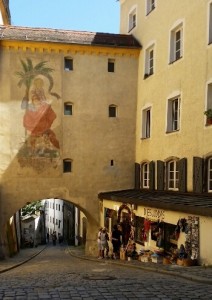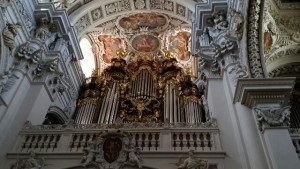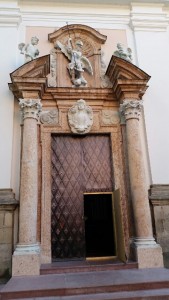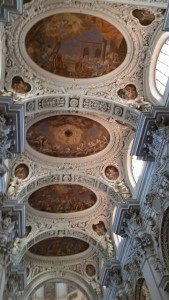Viking’s Danube Waltz (6): Passau
June 6: Passau, Germany
 continued from part 5… Once called “Batavia” or “Batavis,” Passau is a charmer of a medieval Bavarian town at the confluence of the Danube, Inn and Ilz, the last out of the Black Forest, spewing dark peaty water into the larger, faster-moving rivers.
continued from part 5… Once called “Batavia” or “Batavis,” Passau is a charmer of a medieval Bavarian town at the confluence of the Danube, Inn and Ilz, the last out of the Black Forest, spewing dark peaty water into the larger, faster-moving rivers.
 With a population the same as Manchester, New Hampshire, it draws 1.6 million visitors per year, compared to 1 million down at Durnstein, population 400 and a tenth the size. Result: you can move around without masses of crowds and enjoy the transition architecture, Gothic to Baroque.
With a population the same as Manchester, New Hampshire, it draws 1.6 million visitors per year, compared to 1 million down at Durnstein, population 400 and a tenth the size. Result: you can move around without masses of crowds and enjoy the transition architecture, Gothic to Baroque.
 St. Stefan’s Cathedral has one of the largest organs in the world and the recital there is tremendous. Viking crew members tell us they like Passau best of all the stops and you can see why. It’s laid back, picturesque and not inundated with tourists. It doesn’t seem to be trying so hard.
St. Stefan’s Cathedral has one of the largest organs in the world and the recital there is tremendous. Viking crew members tell us they like Passau best of all the stops and you can see why. It’s laid back, picturesque and not inundated with tourists. It doesn’t seem to be trying so hard.
Passau architecture
Temperatures were still steaming as our Viking guide led us around the sights. Passau offers wonderful architecture. We don’t think the churches have one square inch of display place left. We bought local cheeses, strawberries and crusty bread in the open air market. We brought them back to the ship to eat in air-conditioned comfort. The ship provided fine Austrian reds and German whites, and local beer on tap. I am afraid we pigged out: a perfect combination of local cheese and produce and the ship’s ample beverage lists.

 After all that heat, we were looking forward to rainy 60s the next few days in Prague, an “optional extra” to the Danube Waltz Tour, which ends here. The coach ride is four hours, tomorrow morning, through the historic Sudetenland, the area Hitler claimed and won at Munich, which then had an ethnic German minority. Since the war it’s been all Czech. They had their revanche after all.
After all that heat, we were looking forward to rainy 60s the next few days in Prague, an “optional extra” to the Danube Waltz Tour, which ends here. The coach ride is four hours, tomorrow morning, through the historic Sudetenland, the area Hitler claimed and won at Munich, which then had an ethnic German minority. Since the war it’s been all Czech. They had their revanche after all.







